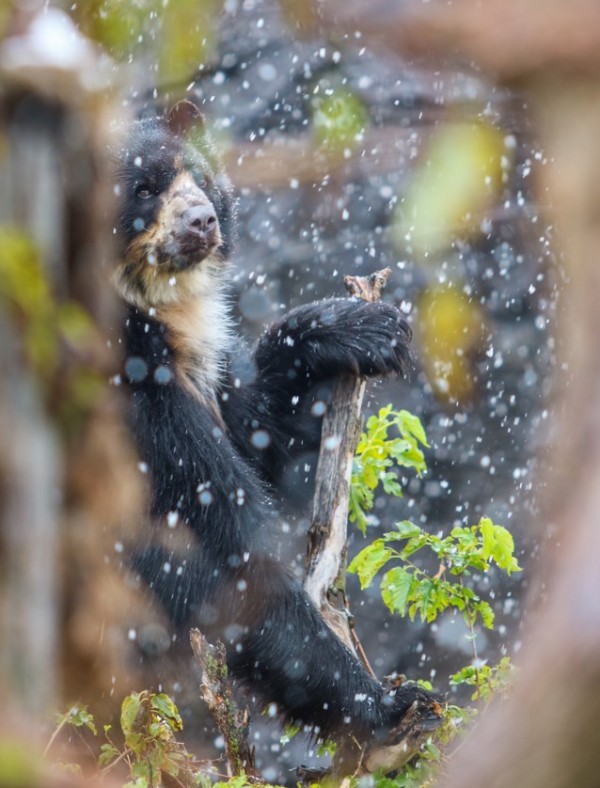Documenting the Andean Bears of Machu Picchu

Camera-Trapping Andean Bears!
In the summer of 2023, a team of scientists and conservationists geared up for an expedition with the goal of studying the living residents of an ancient empire. The team wasn’t studying a human population, though – their focus was the Andean bears of Machu Picchu!
Spectacle Bear Conservation Society (SBC) – a Peruvian non-profit organization dedicated to protecting bears and their habitat – planned and led the journey into the historic park with support from the Peruvian government. Comprised of SBC members, Machu Picchu's park guards, volunteers, and porters, the 26-person team embarked on a three-week expedition to deploy camera traps across the park and start collecting vital data on bear ecology, health and habitat use. Current scientific data is needed to understand how bears may be impacted by threats like increasing tourism pressure and forest fires – and these conclusions will help the Peruvian government identify effective conservation actions. It is also important to understand how bears may be using habitat outside the park.
SBC’s long-term goal is collaborating with the Peruvian government and local communities to create a United Nations Educational, Scientific, and Cultural Organization (UNESCO) Biosphere Reserve protecting 1.5 million acres of land surrounding the Machu Picchu Historic Sanctuary. “Since bears require large habitat areas to thrive, by leading with bear conservation, we can protect entire ecosystems and vast areas of biodiversity,” a representative of SBC said. “This expedition was the critical first step.”
Though the famed Inca Trail (which crosses this historic region) is just 25 miles long, the Machu Picchu Historic Sanctuary spans 125 square miles when accounting for massive elevation gains and drops across the Andes Mountain range. It may be tough going for humans, but the terrain is perfect for Andean bears – also called ‘spectacled bears’ due to their facial fur patterns that resemble glasses. This is the most arboreal of all bear species, and they love a good climb. In fact, Andean bears are also quite crafty, and are known for constructing “nests” in tree canopies.
So, the steep elevations of Machu Picchu may be fitting for an Andean bear – but for humans to journey where bears are most comfortable, bushwhacking and climbing were essential. On top of that, the logistics of transporting more than 1,000 pounds of food, gear and supplies proved added more complexity to an already daunting challenge. “The terrain itself was very challenging, with route-finding and long hiking days across steep mountains and ridges and into very dense forests. We encountered massive elevation gains, hiking up to 16,000 feet above sea level in some areas,” SBC said. “Coming from field work in the hot and arid forest ecosystem in northern Peru, it was also the first time that many of our team members experienced high elevation, very cold temperatures and frost on their tents.”
But teamwork and a shared love for Andean bears made the journey a success. SBC Founder Robyn Appleton and Executive Director Alexander More led the expedition, though many others stepped into leadership roles wherever necessary. The team split into four separate groups to get more than 200 camera traps installed over such a large area. Machu Picchu’s park guards were also an essential part of the team, providing extensive field experience, local knowledge, and a strong passion for protecting nature. Through all the challenges of this unprecedented journey, team members displayed determination and enthusiasm to protect this incredible species dwelling in an iconic, historical region.
“The most rewarding part of this experience was knowing that with every step through the incredible ecosystems of Machu Picchu, we were expanding our impact for bears and biodiversity in Peru,” the SBC said.
While globally-renowned, Machu Picchu is also a source of great local pride and Andean bears are a beloved species in Peru, so SBC is seeing local support for this important work. Indigenous communities have lived alongside Andean bears in the Machu Picchu region for generations, and they are very interested in the project as well. SBC prioritizes community partnerships because empowered communities play a direct role in local conservation decisions and management. Improving community well-being – through conservation education, training and alternative economic opportunities – is key to long-term conservation success.
SBC returned to retrieve their camera traps in October and are in the process of analyzing the data. The camera trap expedition was the first phase of a larger plan; the next phase of the project, set to begin in 2024, will focus on collaring Andean bears. The purpose of the GPS collars is to see if Andean bears travel to any unprotected habitat outside of the Machu Picchu Historic Sanctuary, so SBC and the Peruvian government can coordinate protection of these areas as well.
We at the Rosamond Gifford Zoo proudly care for our fan-favorite Andean bear Bjorn and are so grateful to know that there are dedicated conservationists out there protecting all of Bjorn’s wild counterparts! We can’t wait to see what insights SBC produces with the next phase of their project!
Visit www.sbc-peru.org to learn more about SBC’s work to protect Andean bears in Peru.



